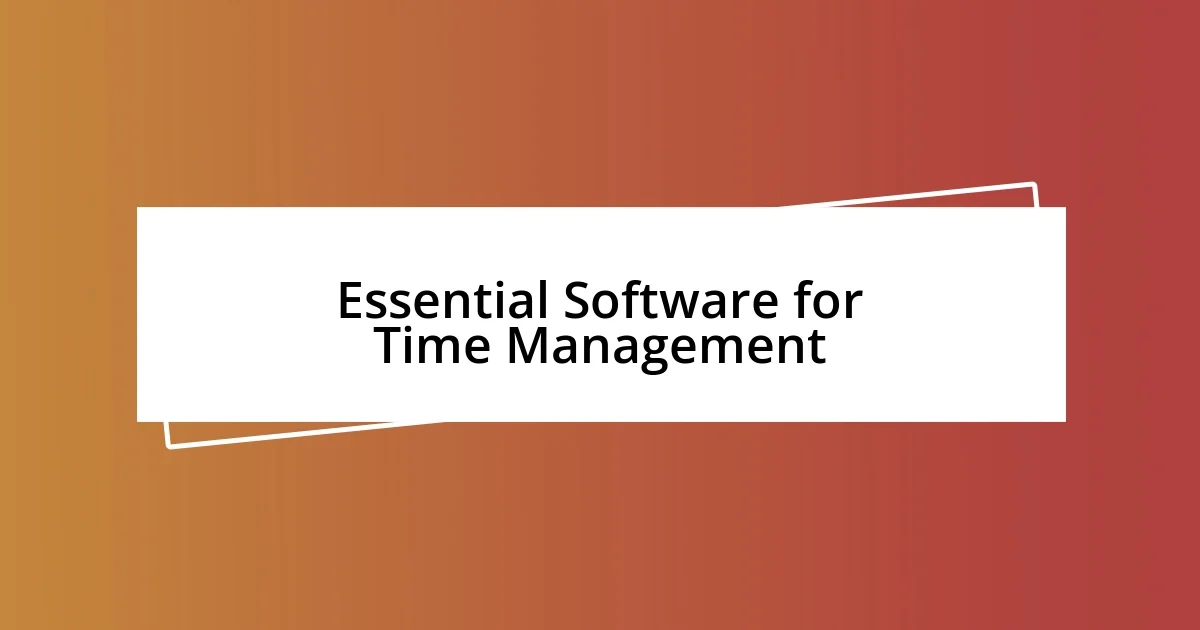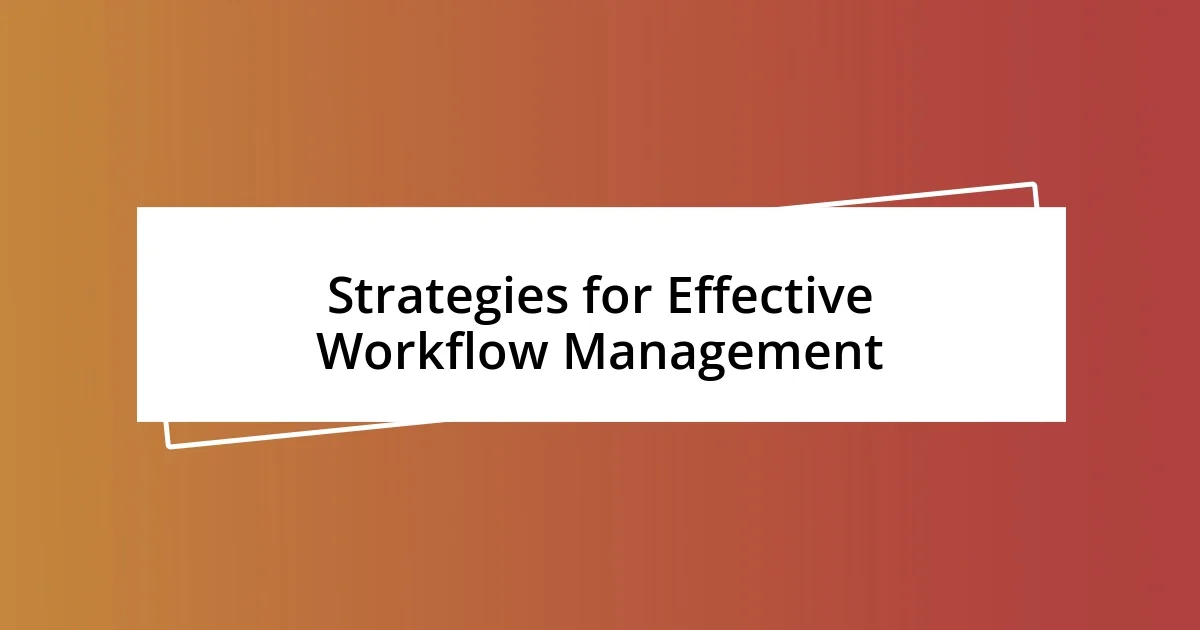Key takeaways:
- Productivity enhancement tools and software, such as project management apps and automation tools, significantly streamline workflow and improve time management.
- Collaboration apps like Slack and Microsoft Teams enhance teamwork and communication, bridging distances and fostering a connected work environment.
- Effective strategies for workflow management include breaking projects into smaller tasks, using visual tools, and conducting regular team check-ins to maintain alignment and communication.

Understanding Productivity Enhancement Tools
Productivity enhancement tools serve as the backbone of effective time management and task execution. Think about those days when your to-do list feels endless, and every minute counts. I remember a particularly overwhelming week when I discovered a project management app; it completely reshaped how I approached my tasks, transforming chaos into clarity.
What if you could streamline your workflow by using tools to automate routine tasks? Imagine having a virtual assistant that sorts your emails or schedules your meetings. That was a game-changer for me—after implementing scheduling software, I found extra hours in my week that I could spend on more creative or strategic pursuits instead of getting bogged down in logistics.
As I explored different tools, I learned that not every solution fits every person. Finding the right apps can be a bit like searching for your perfect pair of shoes; it often takes some trial and error. Have you ever struggled with one tool only to find another one resonates perfectly with your style? Those small victories really enhance my daily productivity, reminding me that the right tool can make all the difference.

Essential Software for Time Management
Effective time management hinges on reliable software that helps keep everything organized. I remember the first time I tried a calendar app; it was like a breath of fresh air. Suddenly, I wasn’t just juggling appointments—I was able to visualize my week, set reminders, and carve out uninterrupted time for focused work. This simple shift made me feel more in control and less overwhelmed.
Here are some essential software tools that can significantly impact your time management:
- Todoist: A user-friendly task manager that lets you prioritize and categorize tasks effortlessly.
- Trello: A visual project management tool that helps you create boards for different projects, keeping everything organized at a glance.
- RescueTime: An app that tracks your activity and productivity levels, providing insights on where you can improve.
- Google Calendar: A classic, yet powerful tool for scheduling, sharing events, and setting reminders.
- Focus@Will: A unique service that combines your personal preferences with productivity-enhancing music, keeping you focused during work sessions.
I’ve found that by experimenting with different tools, I could adapt my workflow to what felt most natural for me. There’s a certain satisfaction in finding that perfect software that clicks—it’s like discovering a hidden rhythm in your daily routine.

Must-Have Apps for Collaboration
Collaboration apps enhance teamwork and communication, which is essential whether you’re working from home or in an office. I recall a time when my team struggled with miscommunication; we often missed important updates. The moment we adopted Slack, it was like a breath of fresh air. Instant messaging with channels to organize discussions transformed our engagement, and I personally felt so much more connected to my colleagues.
As I found my go-to collaboration tools, I noticed that using platforms like Microsoft Teams dramatically improved my ability to share documents and conduct meetings online. The integrated video call feature was crucial during those days when travel wasn’t an option. Now, planning meetings feels seamless, allowing for more engagement and less back-and-forth email. Reflecting on this, it’s fascinating how these platforms can bridge distances and cultivate a sense of camaraderie, even virtually.
Choosing collaboration apps that align with your team’s needs can be game-changing. I remember trying various options with my team to find the perfect fit, which made our project plans and updates feel more synchronized. It’s like finding the right puzzle piece; once it’s in place, everything fits beautifully. Here’s a comparative look at some must-have collaboration apps to help your team thrive:
| App | Main Features |
|---|---|
| Slack | Real-time messaging with channels, file sharing, integrations |
| Microsoft Teams | Video conferencing, document collaboration, chat |
| Trello | Visual project boards, task assignments, due dates |
| Zoom | High-quality video meetings, webinars, recording capabilities |
| Asana | Task tracking, project timelines, team collaboration |

Tools for Automating Repetitive Tasks
Automating repetitive tasks can be a game-changer in how we manage our daily workloads. When I discovered tools like Zapier, it was a revelation. By connecting my favorite apps and automating workflows, I reclaimed hours each week. For example, I set up Zaps to automatically save email attachments to my cloud storage. This small yet impactful change reduced stress and allowed me to focus on more meaningful work—don’t you just love when technology does the heavy lifting for you?
Another fantastic tool I came across is IFTTT (If This Then That). This platform lets you create simple conditional statements that streamline daily tasks. I use it to automatically sync my social media postings across different platforms. The first time I saw my content shared without lifting a finger, I couldn’t help but smile. It’s those little moments of relief that remind me how automation can boost productivity in unexpected ways.
Additionally, I’ve found tools like Microsoft Power Automate to be incredibly helpful for more complex tasks. With its ability to automate workflows across hundreds of applications, it feels like having a personal assistant at my fingertips. I once set up a flow to alert me when certain keywords popped up in emails, eliminating the need to sift through my inbox constantly. Just think about how much time I saved—imagine what you could accomplish if you let automation do the mundane parts of your day!

Strategies for Effective Workflow Management
One effective strategy I’ve employed for managing workflow is breaking large projects into bite-sized tasks. I remember tackling a lengthy report that seemed overwhelming at first. However, by dividing it into smaller sections and setting specific deadlines for each, I found my focus sharpened remarkably. It was like climbing a staircase; with each step, I gained confidence and momentum, making the entire process less daunting.
Another approach I found valuable is utilizing a visual project management tool, such as Trello. I had the pleasure of introducing it to my team during a particularly hectic quarter. The way we could see our progress visually—with tasks moving from “To Do” to “Done”—was exhilarating. Seeing those completed tasks gave each of us a little boost, reinforcing a sense of accomplishment. Isn’t it amazing how something so simple can elevate motivation?
Finally, regular check-ins with my team have been transformative. In my experience, scheduling brief weekly meetings not only ensures everyone is aligned but also fosters open communication. During one of our sessions, we uncovered a miscommunication that could have derailed our project. It struck me then how essential these check-ins are for keeping the workflow smooth and the team engaged. Why wait for issues to arise when you can resolve them proactively?












